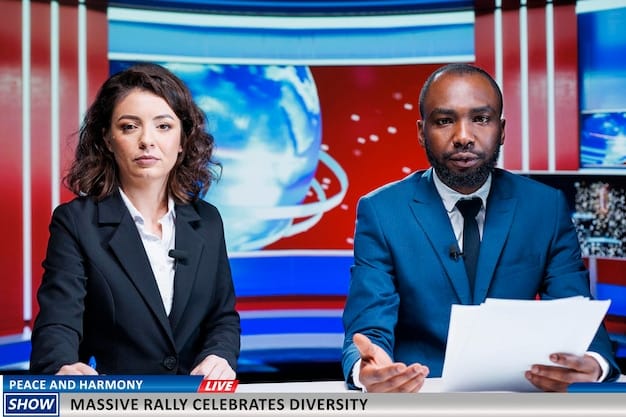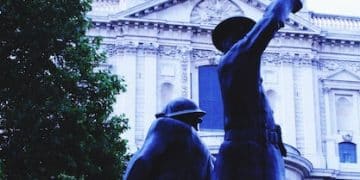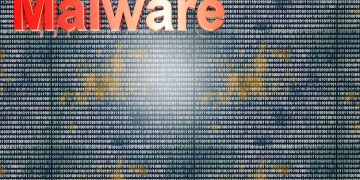Insider Report: Network News Coverage of the Upcoming Election

An insider report on network news coverage of the upcoming election reveals the strategies, challenges, and biases that shape how information is presented to the public, impacting voter perceptions and decisions.
What really goes on behind the cameras and in the newsrooms as networks prepare to cover the upcoming election? This insider report on network news coverage of the upcoming election unveils the hidden layers influencing what viewers see and hear.
The High-Stakes World of Election News
The world of election news coverage is high-stakes, where networks strive to inform the public while navigating intense political pressures. Understanding the dynamics at play is crucial for media literacy.
Election coverage on network news is a carefully orchestrated operation. Networks pour considerable resources into reporting on candidates, policies, and the overall political climate.
Resource Allocation and Coverage Focus
Networks meticulously allocate resources, dedicating significant airtime and manpower to key races and battleground states, aiming to provide viewers with comprehensive election information.
Challenges in Maintaining Objectivity
Maintaining objectivity can be a steeplechase, with network reporters expected to stay neutral amidst growing partisanship and the clamor for ratings. This task can be challenging.
- The need for networks to maintain impartiality.
- The struggle to appeal to a broad audience.
- The ethical dilemmas faced by journalists during heightened political tensions.

In conclusion, election news lives by scrutiny. Balancing accuracy, neutrality, and viewer engagement involves many layers. Understanding these pressures is crucial for informed media consumption.
Bias in the Broadcast: Identifying the Lean
Identifying bias in broadcast media requires a critical eye and an understanding of the subtle ways in which news can be slanted. Viewers should discern potential biases to form their own fact-based opinions.
Bias can manifest in various forms, including selection bias (choosing which stories to cover), framing bias (how the story is presented), and source bias (who is quoted or interviewed).
Spotting the Slant: Types of Bias
To spot bias, it’s essential to understand its different types, such as spin, where facts are presented to favor one side, and omission, where crucial information is left out.
Techniques for Detecting Bias
Viewers can employ various techniques to detect bias, including comparing coverage across multiple networks and evaluating the language used by reporters and anchors.
- Examine the selection of stories and their prominence.
- Evaluate the framing of issues and the language used.
- Assess the diversity and credibility of sources cited.
In summary, identifying bias involves keen awareness. By recognizing subtle forms of bias, discerning viewers can assess networks objectively. This provides viewers the leverage needed to maintain objectivity and make independent judgments.
Behind-the-Scenes Decision Making: What Guides the Coverage?
Understanding what guides the coverage decisions in network news provides valuable insight into how election narratives are shaped. By illuminating the different layers within network newrooms, media literacy can be enhanced.
Editorial meetings, audience research, and political pressures play significant roles in shaping the election coverage viewers ultimately see. Understanding these factors enhances media literacy.
The Role of Editorial Boards and Meetings
Editorial boards and meetings are where key decisions are made about which stories to prioritize, how to frame them, and which sources to consult, influencing the overall narrative presented to viewers.
Impact of Audience Research and Ratings
Audience research and ratings influence coverage, as networks strive to attract viewers while fulfilling their journalistic duty, sometimes leading to controversial content.

To conclude, behind-the-scenes factors profoundly shape election coverage. Recognizing decision-making enhances media literacy, empowering viewers to critically assess the news. This is required for accurate news that informs.
The Impact of Social Media on Traditional Election Reporting
Social media has revolutionized traditional election reporting, changing how news is gathered, distributed, and consumed. Therefore, networks must adapt to maintain their authority.
Social media’s integration into election coverage brings both opportunities and challenges, including the rise of citizen journalism, the spread of misinformation, and the need for fact-checking.
Opportunities and Challenges for Networks
Networks must navigate the opportunities and challenges presented by social media, including using platforms to engage with viewers while combating misinformation and maintaining journalistic standards.
Changes in News Gathering and Distribution
The rise of citizen journalism and real-time updates has transformed news gathering and distribution, compelling networks to adapt their strategies and technologies to keep pace.
- The increased speed of news dissemination.
- The challenge of verifying information from diverse sources.
- The importance of engaging with audiences on social platforms.
Finally, social media’s surge has revolutionized election news. Balancing opportunities and challenges demands keen adaptation. Such adaptation enables fair, accurate reporting that serves viewers fully.
Fact-Checking and Accountability in Election News Coverage
Fact-checking and accountability are essential components of responsible election news coverage. Without fair information for the voters’ information, democracies fail.
Networks employ fact-checking units and accountability measures to ensure the accuracy and integrity of their reporting, addressing misinformation and upholding journalistic standards. This must be maintained to assure voter confidence
The Role of Fact-Checking Units
Fact-checking units play a crucial role in verifying claims made by candidates and political figures, correcting inaccuracies, and holding those who spread false information accountable.
Accountability Measures and Transparency
Accountability measures and transparency are essential for maintaining public trust in election news coverage, including disclosing sources and correcting errors in a timely manner.
- The importance of verifying claims made by candidates.
- The need to correct errors promptly and transparently.
- The ethical responsibility of networks to hold politicians accountable.
On the whole, ensuring fair elections requires fact-checking and accountability. Upholding these standards enables trust. It also enables the public to be reliably informed and engaged with the elections.
The Future of Election Coverage: Trends and Predictions
The future of election coverage is poised for significant transformation, driven by evolving technology, changing audience behaviors, and new modes of engagement. This can be used to better serve the public.
Emerging trends and predictions include the use of artificial intelligence in news gathering, personalized news experiences, and innovative ways to engage younger voters.
Artificial Intelligence and Personalized News
Artificial intelligence is poised to revolutionize news gathering and analysis, enabling networks to deliver more personalized and relevant content to audiences based on their preferences and behaviors.
Engaging Younger Voters
Networks must find innovative ways to engage younger voters, leveraging social media, interactive content, and formats to capture their attention and participation in the electoral process.
- The increasing use of AI in news analysis.
- The shift toward personalized news experiences.
- The importance of capturing the attention of younger demographics.
In conclusion, the future of election news will be shaped by technology and voter behavior. Embracing innovative approaches ensures viewers remain informed. It also ensures they stay engaged in the democratic process.
Ethical Considerations for Journalists Covering Elections
Ethical considerations are paramount for journalists covering elections, influencing their reporting and responsibilities. Ethical reporting assures news credibility.
Journalists face ethical dilemmas such as conflicts of interest, pressures from political actors, and the need to balance objectivity with social responsibility, each must be negotiated with care.
Avoiding Conflicts of Interest
Avoiding conflicts of interest is essential for maintaining journalistic integrity, including disclosing any financial or personal ties to candidates or political organizations, as well as avoiding endorsements.
Balancing Objectivity and Social Responsibility
Journalists must strike a delicate balance between objectivity and social responsibility, ensuring they do not become mouthpieces for political agendas while upholding their duty to serve the public interest. This balance must also include a measure of social awareness.
- The importance of impartiality in reporting.
- The need to disclose potential conflicts of interest.
- The responsibility to serve the public interest.
Finally, ethical considerations guide responsible election news. Ethical journalism fosters viewer trust. It also strengthens the integrity of the electoral process itself.
| Key Point | Brief Description |
|---|---|
| 📺 Objectivity Challenges | Networks face immense pressure to remain neutral. |
| 📊 Bias Detection | Critical viewers compare coverage across networks. |
| 📱 Social Media Impact | Citizen journalism has altered news cycles and reporting. |
| 🤖 AI Integration | AI is set to personalize news with great accuracy. |
FAQ
▼
Selection bias refers to the choice of which stories networks prioritize and cover, which can influence public perception by focusing on certain candidates or issues more than others. This kind of selection favors attention to some stories while neglecting others.
▼
Audience ratings can significantly affect election coverage. Networks often prioritize headline-grabbing stories in efforts to attract viewers, and this can sometimes eclipse more important but less sensational information.
▼
During elections, journalists face conflict-of-interest dilemmas, and must deal with with pressures from political actors, social responsibility needs. Maintaining objectivity while informing the public can prove challenging due to these conflicting factors.
▼
Social media has greatly sped up news cycles, enabled widespread dissemination, and allowed citizen journalists to cover events, offering a direct flow of real-time information while also complicating fact-checking and increasing misinformation risks.
▼
Fact-checking units verify claims by candidates, and hold those spreading false information accountable. By correcting inaccuracies, these units enhance credibility, ensuring the viewing public receives verifiable details for informed decisions.
Conclusion
In conclusion, the behind-the-scenes mechanisms of network news coverage for the upcoming election involve intricate decision-making, ethical considerations, and adaptations to media technologies. Comprehending these elements empowers the public to assess information critically and participate more effectively in democratic discourse.





